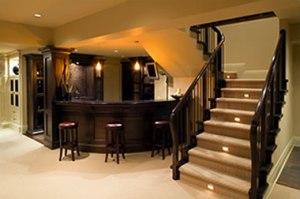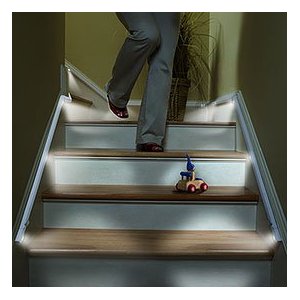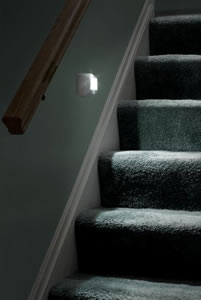
Figure 1 - Staircase illuminated with wall mounted LED step lights.
It should be noted that lights can also be used outdoors to illuminate entry steps, steps from decks and wheelchair ramps. If you are adding lighting to outdoor steps it is important that you purchase fixtures that are rated for outdoor operation.
Overhead lighting, which is common and a building code requirement in most areas, for steps and staircases, has two major negatives:
- In many cases the person using the steps creates a shadow on the steps because their body is actually blocking the light. Properly installed step lighting does not allow the individual to create light shadows that prevent the light from illuminating the steps.
- Individuals using the steps or staircase will not turn on the overhead lighting at night because they may believe that turning on the light will disturb others in the house.
Although there are many types of step lighting fixtures, there are basically only two different methods of providing direct stair or step lighting.
- Provide a light or group of lights that are wall mounted and illuminate the steps, as shown in Figure 1.
- Lights are mounted in the riser of the steps and illuminate one or two steps over the height of the staircase, as shown in Figure 2.

Figure 2 - Staircase illuminated with riser mounted step lights.
Step and staircase lights can be purchased that are powered by a regular AC circuit or with batteries. Both methods; battery or AC powered, have advantages and disadvantages.
Battery powered versus AC powered step lights:
Battery powered step lights:
Advantages:
- Ease of installation.
- They operate even when there is a power failure.
Disadvantages:
- Batteries must be replaced on an on-going basis in order to ensure that the steps or stairs are always illuminated when required.
AC powered step lights:
Advantages:
- Providing there is AC power, they provide illumination and do not require periodic maintenance.
- AC powered step lights can be controlled by an occupancy sensor which will turn the step lights on if an individual is using the steps.
Disadvantages:
- They can be expensive and/or extremely difficult to install as a retrofit, as they require an AC circuit.
- They do not operate if there is a power failure.
Following are some examples of step lighting:

Figure 3 - Motion activated stair LED lighting

Figure 4 - Motion-activated indoor/outdoor stair light
Complete selection of step lights.
